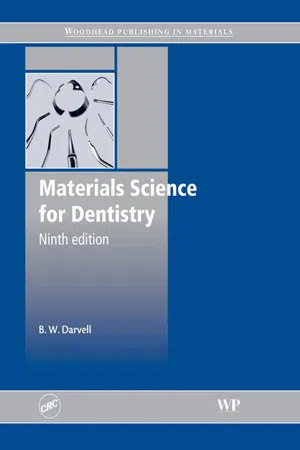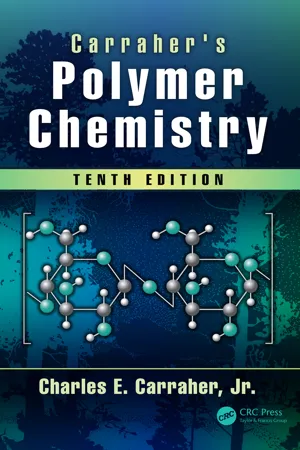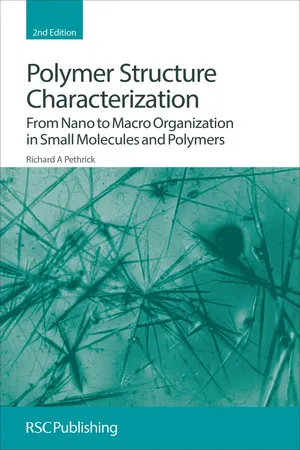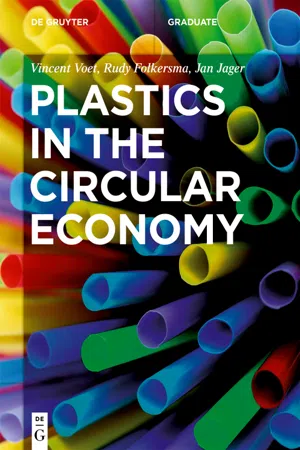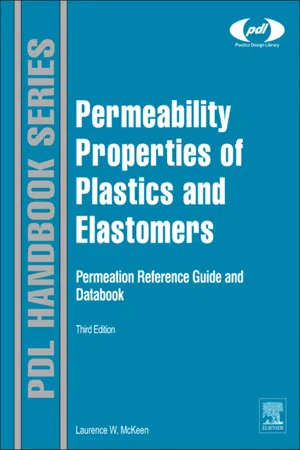Chemistry
Stereochemistry of Polymers
Stereochemistry of polymers refers to the spatial arrangement of atoms in polymer molecules. It involves the study of how the arrangement of substituents around the polymer backbone affects its properties and behavior. Understanding stereochemistry is crucial for designing polymers with specific characteristics, such as strength, flexibility, and thermal stability.
Written by Perlego with AI-assistance
Related key terms
Related key terms
1 of 4
Related key terms
1 of 3
8 Key excerpts on "Stereochemistry of Polymers"
- eBook - ePub
Polymer Fillers and Stiffening Agents
Applications and Non-traditional Alternatives
- Chris Defonseka(Author)
- 2020(Publication Date)
- De Gruyter(Publisher)
The word ‘plastics’ is derived from the Greek word ‘plastikos’. In general, a plastic can be defined as a material that is pliable and capable of being shaped by temperature and pressure. Plastics are based on polymers derived from the Greek word ‘polymeros’, with ‘poly’ meaning many, and meros meaning basic units. Polymers are also called resins in the commercial world, which is not really correct because resins are gum-like substances.Polymer chemistry is a multidisciplinary science that deals with chemical synthesis and chemical properties of polymers, which are considered to be macromolecules. Polymer chemists study the large complex molecules (polymers) that are built from smaller (sometimes repeating) units. They study how these smaller building blocks (monomers) were combined to create useful newer materials with specific characteristics. This is done by manipulating the molecular structure of the monomer/polymers used, the composition of the monomer/polymers combination, and applying chemical and processing technology that can, to a large extent, affect the properties of the final product. Polymer chemists are unique within the chemistry and scientific community because of their special knowledge and understanding of the relationships between polymer structures and their properties, spanning from the molecular to the macroscopic state.Although most polymer chemists work on applied research and development of polymers, there are opportunities for fundamental research (mainly in universities, government laboratories, and industrial labs) on theory of polymers in solid and liquid states, on the synthesis of new polymer structures, and also on the mechanical, electronic, optical, biological and other properties of those new polymers are supposed to have. Polymer chemistry and fundamental polymer research are inherently interdisciplinary, spanning chemistry, physics, engineering, economics and even biology.2.2 What are polymers?
A polymer is a large molecule (macromolecule) composed of repeating basic structural units. These subunits are typically connected by covalent chemical bonds. Although the term ‘polymer’ generally refers to plastics, it encompasses a larger class of compounds, comprising natural and synthetic materials with a wide variety of properties. Because of the extraordinary range of polymeric materials, they have essential and vital roles in everyday life of people. They broadly range from the very familiar synthetic plastics and elastomers to natural biopolymers such as nucleic acids and proteins, which are essential for life. - eBook - ePub
- B W Darvell(Author)
- 2009(Publication Date)
- Woodhead Publishing(Publisher)
configurational isomers .Fig. 2.1 The four substituents of asymmetric carbon atoms can be arranged in mirror-image forms, non-superimposable by rotation.When the monomer has four distinguishable substituents on a carbon atom that will form part of the backbone chain of a polymer, or such asymmetric carbon atoms arise as a result of the polymerization reaction itself, as occurs in poly(methyl methacrylate) (Chap. 5 ), several possibilities arise for the configuration of the side chains or substituents of that polymer. Hence, polymers with asymmetric carbons are distinguishable by configuration, and are permanently locked into their particular condition, allowing discrimination between the various kinds.To assist in the interpretation of three-dimensionalmolecular structures, there are various conventions for drawing the stereochemistry of molecular bonds. This isone such:•2.3 Tacticity
While conformation relates to internal movements of molecules, and configuration the way in which a chain is built at any asymmetric carbon, tacticity refers to the ordering of the configuration sequence of a polymer. Thus, if the relative positions of the substituents are always the same, from asymmetric centre to asymmetric centre, along the length of the chain, the polymer is said to be isotactic (Fig. 2.2 ), whereas an alternating configuration is called syndiotactic . The occurrence of these two arrangements commonly depends on complex steric constraints and they require specialized reaction conditions and methods to be realized. However, for many systems, such as with methyl methacrylate as monomer, no such conditions apply, and the polymer produced is atactic : the substituents are randomly arranged - there is no regularity along the chain. This condition of atacticity has important consequences for the structure of the solid. Because the former two regular types have a repeating structure, not just chemically but also in configuration, they can readily be formed into regular arrays, given that this will require some rotation about successive chain bonds to achieve the correct orientation at each carbon atom. Such polymers therefore can often crystallize quite readily, whereas atactic polymers simply can not crystallize. They are amorphous, resulting in materials which are less brittle than their crystalline counterparts. Crystallinity in polymers is explored further below (§4 - eBook - ePub
Polymer Blends and Composites
Chemistry and Technology
- Muralisrinivasan Natamai Subramanian(Author)
- 2017(Publication Date)
- Wiley-Scrivener(Publisher)
Tacticity is defined as molecules requiring a longer sequence of stereoregular structure before discrete reflections can be observed. The stereoregularity of polymer molecules is a microstructural feature of great importance which determines, to a large extent, the bulk properties and hence the commercial value of many polymeric materials.Subtle variations in chain tacticity may lead to a significant impact on the related properties such as crystallizability, thermal stability, and mechanical strength. Atactic polystyrene exhibits noncrystalline nature, however, both isotactic and syndiotactic polystyrene show crystallizable behavior; the crystallization rate is about one order faster for syndiotactic polystyrene than that for isotactic polystyrene at a given super cooling degree [39–41].For vinyl polymers such as polypropylene (PP) and poly(methyl methacrylate) (PMMA), the tacticity has an effect on chain conformations [42–44] and molecular-dynamic simulation [45–47]. Stereoregularity in the polymers affects the local conformation, which, in turn, affects specific group interactions with other constituent polymers and hence the miscibility is varying tacticity with similar thermal behavior (i.e., Tg ) in order to distinguish the effect of tacticity on conformation and intermolecular interaction from that on more local segmental mobility (related to Tg ). Tacticity can have an effect on the phase diagram of a binary mixture [48]. Conformational differences between polymers of differing tacticities can have an impact on blend phase behavior.3.2.4 Intermolecular Forces
Polymer chains are long and their interchain forces are amplified far beyond the attractions between conventional molecules. Different side groups on the polymer can tend to have ionic bonding or hydrogen bonding between their own chains. Stronger force results in higher tensile strength and higher crystalline melting points.Polymers, such as polyethylene and polypropylene, can form hydrogen bonds as intermolecular force between adjacent chains. Therefore, it can result in high tensile strength and melting point of the polymers. In many polymers the functional group within the polymer chains can have dipole-dipole interactions. However, these are not as strong as hydrogen bonding. The melting point of such polymers will be lower than hydrogen-bonded polymers but the dipole-bonded polymers will have greater flexibility. Therefore, the attractive forces between polymer chains play a large part in determining polymer properties. - eBook - ePub
- Charles E. Carraher Jr.(Author)
- 2017(Publication Date)
- CRC Press(Publisher)
2.12 .The tertiary structure describes the shaping or folding of the polymer. Examples of this are given in Figures 2.13a and 2.14 .Finally, the quaternary structure represents the overall shape of groups of tertiary structures where the tertiary structures may be similar or different. Examples are found in Figures 2.14 and 2.15 .2.1 Stereochemistry of PolymersThe terms “memory” and “to remember” are similar and used by polymer chemists in similar, but different ways. The first use of the terms “memory” and “to remember” involves reversible changes in the polymer structure usually associated with stress–strain deformation of a flexible or somewhat flexible material where the dislodged, moved polymer segments are connected to one another through chemical and physical crosslinks so that once the particular stress–strain is removed, the polymer returns to its original, prestress–strain arrangement of the particular polymer segments. Thus, the polymer “remembers” its initial segmental arrangement and returns to it through the guiding of the crosslinks and other primary and secondary bonding.The second use involves nonreversible changes of polymer segments and whole-chain movements also brought about through stress–strain actions or other means to effect nonreversible changes. These changes include any synthetic chain and segmental orientations as well as postsynthesis changes including fabrication effects. These changes involve “permanent” differences in chain and segmental orientation and in some ways these changes represent the total history of the polymer materials from inception (synthesis) through the moment when a particular property or behavior is measured. These irreversible or nonreversible changes occur with both crosslinked and noncrosslinked materials and are largely responsible for the change in polymer property as the material moves from being synthesized, processed, fabricated, and used in whatever capacity it finds itself. Thus, the polymeric material “remembers” its history with respect to changes and forces that influence chain and segmental chain changes. The ability of polymers to “remember” and have a “memory” is a direct consequence of their size. - eBook - ePub
Polymer Structure Characterization
From Nano to Macro Organization in Small Molecules and Polymers
- Richard A Pethrick(Author)
- 2015(Publication Date)
- Royal Society of Chemistry(Publisher)
CHAPTER 1 Concept of Structure–Property Relationships in Molecular Solids and Polymers1.1 INTRODUCTION
Low molar mass organic molecules and polymeric materials are often found as solids and their physical properties are a consequence of the way in which they are organized: their morphology. The morphology is a result of specific molecular interactions which control the way in which individual molecules pack together to form a solid. Depending on the strength and nature of the interaction, a short- or long-range structure may be created and this leads to the formation of a crystalline, liquid crystalline, gel or amorphous solid. As we shall see later, the organization created at a molecular level may influence the longer range structures, but in other cases it does not, hence the subtitle of the book: From Nano to Macro Organization in Small Molecules and Polymers .Synthetic polymers, often referred to as plastics , are familiar in the house as furniture, form the frames for double glazed windows, shopping bags, furnishings, carpets, curtains and covering for chairs, cabinets for televisions, paper and paint on the walls. Outside the house, plastics are used for septic, water and fuel storage tanks, garden furniture, water hoses, traffic cones, and they play an important part in automobiles, aircraft and sundry other items which we see around us. Removal of all articles containing polymers from a room would leave it bare and would require removal of human beings themselves, as we are all made up of polymeric materials. Synthetic plastics form the basis for many forms of food packaging, containers for cosmetics, soft drink containers and the trays used in microwave cooking of food. Natural polymers such as wood, cotton and wool all exhibit a high degree of order. Biopolymers, which are the very substance of life—as a consequence of specific, usually hydrogen bonding interactions—create morphology which forms the scaffold for life. Many inorganic oxides, silicates, phosphorous, boron nitride, sulphur etc - eBook - ePub
- Vincent Voet, Jan Jager, Rudy Folkersma(Authors)
- 2021(Publication Date)
- De Gruyter(Publisher)
3 .2.4 Polymer materials
So far, we have encountered a wide variety of macromolecules. Depending on the synthetic approach, polymers will differ in chain length, composition, configuration, degree of branching, and crosslink density. These factors drastically influence the performance of plastics. The unique characteristics of polymeric materials are the subject of the following section.2.4.1 Polymer morphology
The term morphology is derived from the Greek wordsμ o ρ φ(morphe = “form”) andη ´λ(logos = “word” or “study”). In polymer science, morphology describes the structure of polymers on the (macro)molecular level. In the solid state, macromolecules can be arranged randomly or in an organized manner. Amorphous polymers present a random chain structure, while crystalline polymers are well-defined and show a highly organized morphology (Fig. 2.40 ). The arrangement of macromolecules has a significant influence on the properties of the polymer material [25 ].o ´γ o ςFigure 2.40 Schematic representation of molecular chain arrangement in solid state: amorphous and crystalline polymers.Crystalline materials have a highly ordered molecular structure. Common examples are sodium chloride (NaCl), or table salt, sugar, and diamonds. The transition from liquid to solid state is called crystallization. Due to their large molecular chain structure, the crystallization of polymers is usually imperfect. This results in a partially crystalline morphology with both amorphous and crystalline domains, i. e., a semi-crystalline polymer. Crystallinity - Laurence W. McKeen(Author)
- 2011(Publication Date)
- William Andrew(Publisher)
2. Introduction to Plastics and PolymersThis chapter is an introduction to polymer chemistry. It includes polymerization chemistry and the different types of polymers and how they differ from each other. The subjects of copolymers, branching, cross-linking, steric hindrance, isomerism, crystallinity, and other factors that affect the molecular structures of the polymers used to make plastics are discussed in this chapter. Since plastics are rarely “neat,” reinforcement, fillers, and additives are reviewed. The influence of molecular structure on permeation is examined. A basic understanding of plastic and polymer chemistry will make the discussion of permeation of specific plastics, films, and membranes easier to understand, and it also provides a basis for the introductions of the plastic families in later chapters.The most basic component of plastic and elastomer materials is polymer. The word polymer is derived from the Greek term for “many parts.” Polymers are large molecules that comprised many repeat units called monomers that have been chemically bonded together into long chains. Since World War II, the chemical industry has developed a large number of synthetic polymers to satisfy the needs of the materials for a diverse range of products, including paints, coatings, fibers, films, elastomers, and structural plastics. Literally, thousands of materials can be called “plastics,” although the term today is typically reserved for polymeric materials, excluding fibers, which can be molded or formed into solids or semisolid objects. The subject of this section includes polymerization chemistry and the different types of polymers and how they can differ from each other. Since plastics are rarely “neat,” reinforcement, fillers and additives are reviewed. A basic understanding of plastic and polymer chemistry will make the discussion of permeation of specific plastics, films, and membranes easier to understand, and it also provides a basis for the introductions of the plastic families in later chapters. This section is taken from The Effect of Temperature and Other Factors on Plastics- eBook - ePub
Physical Chemistry of Polymers
A Conceptual Introduction
- Sebastian Seiffert(Author)
- 2023(Publication Date)
- De Gruyter(Publisher)
1 Introduction to polymer physical chemistry Lesson 1: Introduction As a starting point of our endeavor, the first lesson of this book will introduce you to the fundamental terms and basics in the field of polymer science, along with its historical development. You will learn what a polymer actually is, why these large molecules are interesting, and what the fundamental differences are in their treatment compared to classical materials that are built up of small molecules. 1.1 Targets of this book The prime goal of polymer physical chemistry is to understand the relations between structure and properties of polymers. Once such understanding is achieved, molecular parameters can be rationally connected to macroscopic behavior of polymer-based matter. This connection bridges the fields of polymer chemistry and polymer engineering, as shown in Figure 1, thereby allowing polymer materials to be tailored by rational design. Even though these fields may first seem far apart and separated (by an impassable water body in Figure 1), the discipline of polymer physical chemistry arcs and connects them. (And in the end, by looking underneath the water, we realize that they are actually connected inherently.) Figure 1: Polymer physical chemistry builds a bridge between polymer chemistry, which focuses on the primary molecular-scale structure of polymer chains, and polymer engineering, which focuses on the macroscopic properties of polymer materials. This connection allows for a rational design of polymer-based matter to obtain tailored materials. To erect the bridge, three pillars are required: single chain statistics, multichain interactions, and chain dynamics. These pillars are in the focus of the second, third, and fourth chapters of this book
Index pages curate the most relevant extracts from our library of academic textbooks. They’ve been created using an in-house natural language model (NLM), each adding context and meaning to key research topics.
Explore more topic indexes
Explore more topic indexes
1 of 6
Explore more topic indexes
1 of 4

